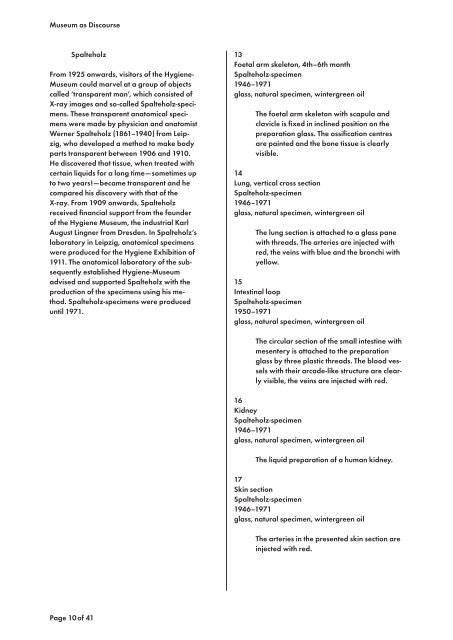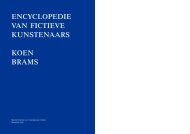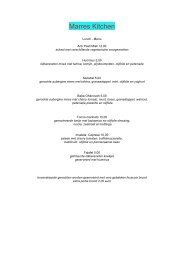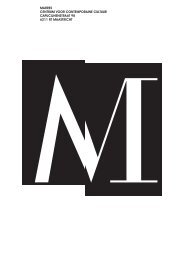Hygiene The story of a museum - Marres
Hygiene The story of a museum - Marres
Hygiene The story of a museum - Marres
You also want an ePaper? Increase the reach of your titles
YUMPU automatically turns print PDFs into web optimized ePapers that Google loves.
Museum as Discourse<br />
Spalteholz<br />
From 1925 onwards, visitors <strong>of</strong> the <strong>Hygiene</strong>-<br />
Museum could marvel at a group <strong>of</strong> objects<br />
called ‘transparent man’, which consisted <strong>of</strong><br />
X-ray images and so-called Spalteholz-specimens.<br />
<strong>The</strong>se transparent anatomical specimens<br />
were made by physician and anatomist<br />
Werner Spalteholz (1861–1940) from Leipzig,<br />
who developed a method to make body<br />
parts transparent between 1906 and 1910.<br />
He discovered that tissue, when treated with<br />
certain liquids for a long time — sometimes up<br />
to two years! — became transparent and he<br />
compared his discovery with that <strong>of</strong> the<br />
X-ray. From 1909 onwards, Spalteholz<br />
received financial support from the founder<br />
<strong>of</strong> the <strong>Hygiene</strong> Museum, the industrial Karl<br />
August Lingner from Dresden. In Spalteholz’s<br />
laboratory in Leipzig, anatomical specimens<br />
were produced for the <strong>Hygiene</strong> Exhibition <strong>of</strong><br />
1911. <strong>The</strong> anatomical laboratory <strong>of</strong> the subsequently<br />
established <strong>Hygiene</strong>-Museum<br />
advised and supported Spalteholz with the<br />
production <strong>of</strong> the specimens using his method.<br />
Spalteholz-specimens were produced<br />
until 1971.<br />
Page 10 <strong>of</strong> 41<br />
13<br />
Foetal arm skeleton, 4th–6th month<br />
Spalteholz-specimen<br />
1946–1971<br />
glass, natural specimen, wintergreen oil<br />
<strong>The</strong> foetal arm skeleton with scapula and<br />
clavicle is fixed in inclined position on the<br />
preparation glass. <strong>The</strong> ossification centres<br />
are painted and the bone tissue is clearly<br />
visible.<br />
14<br />
Lung, vertical cross section<br />
Spalteholz-specimen<br />
1946–1971<br />
glass, natural specimen, wintergreen oil<br />
<strong>The</strong> lung section is attached to a glass pane<br />
with threads. <strong>The</strong> arteries are injected with<br />
red, the veins with blue and the bronchi with<br />
yellow.<br />
15<br />
Intestinal loop<br />
Spalteholz-specimen<br />
1950–1971<br />
glass, natural specimen, wintergreen oil<br />
<strong>The</strong> circular section <strong>of</strong> the small intestine with<br />
mesentery is attached to the preparation<br />
glass by three plastic threads. <strong>The</strong> blood vessels<br />
with their arcade-like structure are clearly<br />
visible, the veins are injected with red.<br />
16<br />
Kidney<br />
Spalteholz-specimen<br />
1946–1971<br />
glass, natural specimen, wintergreen oil<br />
<strong>The</strong> liquid preparation <strong>of</strong> a human kidney.<br />
17<br />
Skin section<br />
Spalteholz-specimen<br />
1946–1971<br />
glass, natural specimen, wintergreen oil<br />
<strong>The</strong> arteries in the presented skin section are<br />
injected with red.






